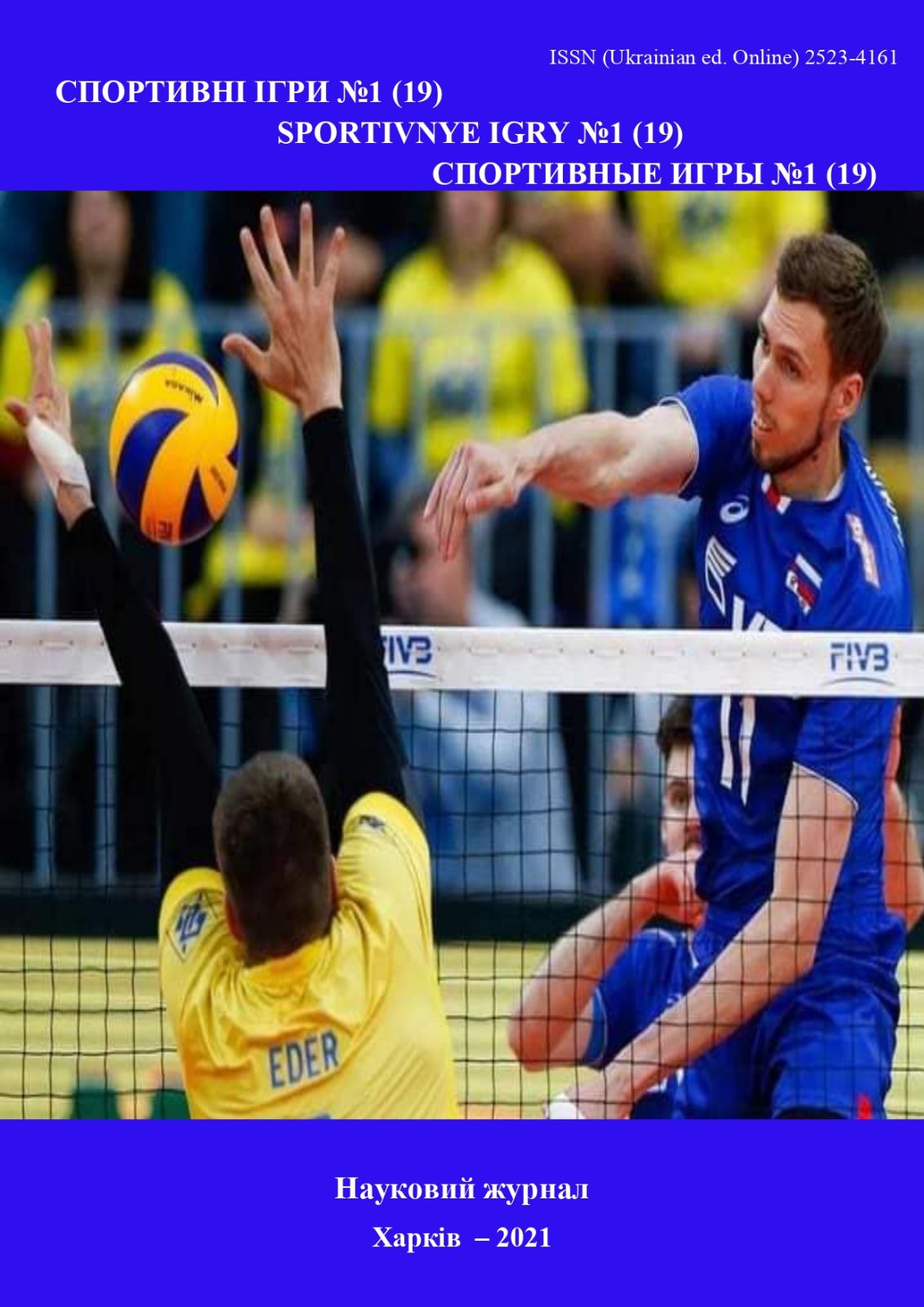Модельні характеристики сенсомоторних показників студентів ХДАФК спортивної спеціалізації «бадмінтон, теніс»
DOI:
https://doi.org/10.15391/si.2021-1.8Ключові слова:
модельні характеристики, студенти, показники, сенсомоторні реакції, специфічні сприйняття, теніс, бадмінтонАнотація
Мета: розробити модельні характеристики сенсомоторних показників студентів ХДАФК спортивної спеціалізації «бадмінтон, теніс». Матеріал і методи. У дослідженні використовувалися наступні методи: аналіз науково-методичної літератури, джерел Інтернету і узагальнення передового практичного досвіду, психофізіологічні методи дослідження, методи математичної статистики. У дослідженні взяли участь 22 студента Харківської державної академії фізичної культури (ХДАФК) спортивної спеціалізації «бадмінтон, теніс». Вік учасників від 18 до 22 років. Спортсмени мали кваліфікацію від 2 розряду до кандидата в майстри спорту. Результати: на підставі аналізу науково-методичної літератури, джерел Інтернету і узагальнення передового практичного досвіду було виявлено, що специфіка змагальної діяльності спортсмена накладає свій відбиток на рівень розвитку провідних сенсомоторних реакцій, які забезпечують високі спортивні досягнення. В ході дослідження була виконана оцінка: простих сенсомоторних реакцій (проста моторика; стійкість до збиваючих факторів;
проста слухо-моторна реакція), складних сенсомоторних реакцій (реакція вибору з
статичних об'єктів; реакція на рухомий об'єкт; реакція розрізнення), специфічних
сприйнятть (оцінка почуття темпу; оцінка сприйняття зміни розміру об'єкта). Висновки:
отримані дані свідчать про однорідність показників простих і складних реакцій
досліджуваних студентів (від 5,46 % до 10,65 %), крім показника складної реакції на об'єкт, що рухається, який має високий коефіцієнт варіації (28,32 %). Показники в тестах, які відображають специфічні сприйняття студентів, також мають високий коефіцієнт варіації (від 13,56 % до 35,53 %), це пояснюється тим, що специфічні сприйняття і
показники складної реакції на об'єкт, що рухається відображають, в більшій мірі,
індивідуальний, генетично обумовлений, характерний для конкретного спортсмена
психофізіологічний стан. Розроблено модельні характеристики сенсомоторних реакцій і
специфічних сприйнятть студентів спортсменів ХДАФК спортивної спеціалізації
«бадмінтон, теніс», які можуть стати основою для створення експрес діагностик
готовності до змагань.
Посилання
Асєєва, Я.Ф. & Шевченко, О.О (2019). Взаємозв’язок психофізіологічних показників та технічної підготовленості у спортсменів з настільного тенісу на етапі попередньої базової підготовки. Слобожанський науково-спортивний вісник, 6, 5-9.doi.org/10.15391/snsv.2019-6.021
Ашанин, В.С., & Романенко, В.В. (2015). Использование компьютерных технологий для оценки сенсомоторных реакций в единоборствах. Слобожанський науковоспортивний вiсник, 4, 15-18. dx.doi.org/10.15391/snsv.2015-4.002
Беленко, И.С. (2009). Психофизиологические особенности у юных спортсменов игровых видов спорта разного возрастного периода развития и тренированности. Вестник ТГПУ, 3(81), 54-58.
Запорожанова, А.А. (2007). Обоснование показателей контроля психофизиологического состояния теннисистов 12-15 лет. Педагогика, психология и медико-биологические проблемы физического воспитания и спорта. (7). 53-57.
Креспо, М., Рейд, М., & Квин, Э. (2006). Психология в теннисе: 200 + практические упражнения и современные исследования. Валенсия: ITF.
Луцик, М., Пильтяй, С., & Клиндух, Т. (2016). Вплив засобів настільного тенісу на рівень спеціальної фізичної підготовленості студентів у процесі підвищення спортивної майстерності. Науковий вісник Миколаївського національного університету, (1), 30-33.
Мирошниченко, Є.С., Тропін, Ю.М., & Коваленко, Ю.М. (2020). Модельні характеристики психофізіологічних показників кваліфікованих кікбоксерів. Слобожанський науковоспортивний вісник, 5(79), 20-25. doi.org/10.15391/snsv.2020-5.003
Мінгальов, О.Г., & Дрегваль, І.В. (2017). Аналіз функціонального стану сенсомоторної реакції та основних нервових процесів спортсменів ігрових видів спорту. Вісник проблем біології і медицини, 2(140), 268-270.
Начинская, С.В. (2005). Спортивная метрология: пособие для студентов высших учебных заведений. Москва : «Академия».
Первачук, Р.В., Тропин, Ю.Н., Романенко, В.В., & Чуев, А.Ю. (2017). Модельные характеристики сенсомоторных реакций и специфических восприятий
квалифицированных борцов. Слобожанський науково-спортивний вісник, 5, 84-88.doi:10.15391/snsv.2017-5.015
Ровний, А.С. (2002). Психофізіологічні основи спеціальної працездатності спортсменів у спортивних іграх. Педагогіка, психологія та медико-біологічні проблеми фізичного виховання і спорту, 22, 45-52.
Ровный, А.С., & Романенко, В.В. (2016). Модельные характеристики сенсомоторных реакций и специфических восприятий единоборцев высокой квлификации. Единоборства, 12, 54-57.
Тропин, Ю.Н., Романенко, В.В., Голоха, В.Л., & Алексеева, И.А. (2018). Особенности проявления сенсомоторных реакций студентами ХГАФК. Слобожанський науковоспортивний вісник, 3, 57-62. doi.org/10.15391/snsv.2018-3.010
Улізько, В. (2009). Психоемоційна складова функціонального стану спортсменок з настільного тенісу високої кваліфікації. Молода спортивна наука, Т.1. 288-292.
Шевченко, І.М. (2008). Оцінка функціонального стану системи аналізаторів спортсменокбадмінтоністок. Запорожский медицинский журнал, (52), 45-48.
Шевченко, О.О., Мерзлікін, М.М., & Чуча, Н.І. (2020). Порівняльний аналіз показників моторної функціональної асиметрії у студентів спортивної спеціалізації бадмінтон, теніс. Спортивні ігри, 3(17), 115-124. doi: 10.15391/si.2020-3.11
Iermakov, S., Podrigalo, L., Romanenko, V., Tropin, Y., Boychenko, N. & Rovnaya, O. (2016). Psycho-physiological features of sportsmen in impact and throwing martial arts. Journal of Physical Education and Sport, 16, 433-441. doi:10.7752/jpes.2016.02067
Podrigalo, L., Iermakov, S., Romanenko, V., Rovnaya, O., Tropin, Y., Goloha, V., & Halashko, O. (2019). Psychophysiological features of athletes practicing different styles of martial arts -the comparative analysis. International Journal of Applied Exercise Physiology, 8(1), 84-91.doi:10.30472/ijaep.v8i1.299













